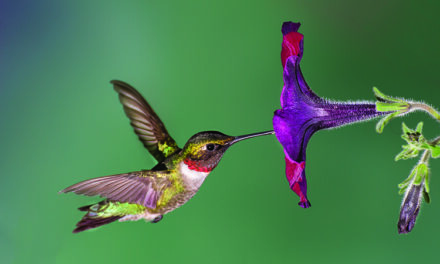
Peas, one of the earliest crops in Missy Corley’s urban garden, bring with them hope and excitement for another gardening season. (Photo by Missy Corley)
When Missy Corley moved into her cozy Easton home in 2010, the tenth-acre plot featured a small front lawn with a smattering of plants tucked off to the side.
As a youngster, Corley enjoyed her family home’s landscaped yard, but took no active part in gardening.
In recent years, though, the book “Animal, Vegetable, Miracle” by Barbara Kingsolver, inspired her abiding interest in personal food production.
Despite the Easton property’s space limitations, instead of waning, that interest grew.
Finally, in 2015, tiring of the ongoing chore of mowing, she noticed how much sun the south-facing grassy area received.
Soon after, she began plotting a way to transform it from turf to garden patch.
Using a method called lasagna mulching or sheet mulching, Corley took on the project in segments, covering up the grass on half of her lawn that first year with cardboard and then layering on topsoil mixed with compost and mulch.
She then hand shoveled several tons of the trucked mixture, a time consuming and labor-intensive process.
Her first crops were mainly annuals, including tomatoes, squash, corn, kale, and cucumbers plus sunflowers, chamomile, and zinnias.
The following year Corley transitioned the remaining lawn to garden using the same method. But her planting choices morphed more toward perennials to streamline upkeep.
From the start, her urban neighbors have taken the front yard garden “miracle” in their midst in stride.
“There’s no HOA where I live,” she said, so no restrictions about growing even 8-foot cornstalks.
Since starting, she has received only a single notice of a town infraction, last year, concerning plants encroaching on the sidewalk.
And she frequently fields friendly questions from people seeking her advice on what would work best in their yard, particularly this year.
The corn, especially, did attract attention, notably from pesky raccoons — who displayed amazing skill climbing the towering stalks, husking the ears — leaving behind depleted gnawed-on cobs as evidence.
This year, in hopes of deterring them, Corley plans on trying a less sweet popcorn varietal.
She also keeps an eye out for rabbits, squirrels and other critters who might hinder her progress.
But she has concluded that a “resident” cat on her street provides more help than hindrance with rodent pest control.
For a bit of extra protection, Corley institutes a border of “sacrificial” ornamental planting as a first line of defense for the crops she hopes to harvest.
A few years ago, after a holly tree tucked back in a corner of her side yard came down in a storm, Corley converted the space into a 6-foot by 3-foot raised bed.
But before long, an unknown bug began to plague the plants she’d carefully sown.
To identify and combat the intruding insect, she reached out to a Master Gardener friend whose six-inch-thick manual helped pinpoint the culprits as harlequin bugs — “an awful stinkbug lookalike” according to Corley.
Desirous of acquiring a hefty gardening guidebook of her own, Corley enrolled in the Master Gardener program, earning certification in 2016.
Among Corley’s Master Gardener project initiatives was the creation of Talbot County Public Library’s Seed Library, housed at both Library branches in Easton and St. Michaels.
The Seed Library offers a selection of numerous varieties of gardening seeds free of charge and accepts donations in return.
Although the library building needed to close due to the COVID-19 virus, Corley is still able to provide interested gardeners with seeds she’d stored in her home from last year, packing them for a safe, socially distant pick up.
Since it began, the Seed Library has received donations of overflow seed packets from catalogues and other supply sources.
But this year’s economic and food challenges have helped fuel overwhelming market demand for seeds, causing many companies to sell out of their supply, potentially depleting “leftover” stock to donate next year.
Because of that, there will likely be a greater need for seeds saved by gardeners themselves, she noted.
For her own growing needs, the virus’ impact has motivated Corley to cultivate veggies which are more nutrient dense veggies and those which store well, such as regular and sweet potatoes.
Long-term planning has also figured into her planting of two “teeny” pomegranate trees, currently under a foot tall, on either side of her front stoop.
Native specimens, including blueberry bushes, elderberry, and fig are in progress, along with sage, mug wort, beebalm and peas.
For upkeep and maintenance, Corley said she keeps things simple. At first, she tried drip irrigation lines, but when her garden set-up required rearranging, that system proved to be “a lot more work than expected,” she said.
Now, rain barrels and hand watering with a long hose are more than enough to suit her needs.
To keep pests under control, Corley hand checks her plants, going out early in the morning, especially during the warmer season.
But the best method, she believes, is to have the healthiest plants possible.
For more information about the Talbot County Free Seed Library, visit https://www.facebook.com/talbotcountyfreeseedlibrary/.





